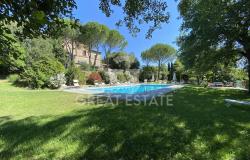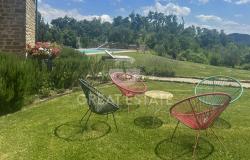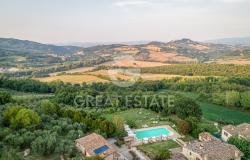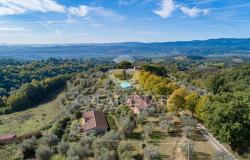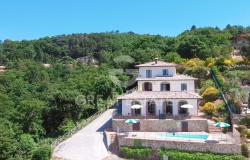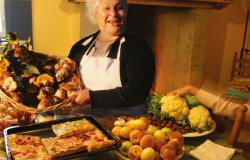Words by Pat Eggleton
If you are a fan of Italian pottery, you’ll love this blog. Read on to learn about Tiziana and Manuela, two friends whose passion for pottery led to a business…
Tiziana, can you tell us where you and Manuela are from?
We are both 100% Italian. Manuela was born in Trieste. When she was a child, she lived in many different cities before making Perugia, in Umbria, her hometown. I’m from Rome, but actually Umbria is where I feel at home. It does a lot of good to my soul!
 When did you first become friends?
When did you first become friends?
Oh, well! A long time ago. We met about 18 years ago, when we both lived in Rome and our husbands worked for the same company. It was ”friendship at first glance”.
And then you both travelled quite a bit, is that right? Was this because of your own or your husbands’ work?
Yes, we both travelled a lot, due to our husbands’ international assignments. But we always managed to keep in touch and we were always there for each other, even when Manuela lived in Singapore and I lived in Switzerland, even before Skype and cheap international phone rates.
And now, as you say, you don’t live close enough to meet every week but close enough to meet sometimes?
Manuela moved back to Perugia a few years ago, some time after I had also moved back to Italy, to Viterbo. It’s only 80 miles from Manuela’s place so we manage to meet pretty often, especially in summer, when the kids don’t go to school.
When and how did you both become interested in Italian pottery? I personally started collecting pottery in 1997. At the time I lived on the Italian east coast. One day I decided to take a day off and drive by myself to Castelli, in Abruzzo. I knew it was a pretty village, famous for its pottery, which is often decorated with elaborate landscapes. I had not found much information on its attractions, though, so I did not expect much.
I personally started collecting pottery in 1997. At the time I lived on the Italian east coast. One day I decided to take a day off and drive by myself to Castelli, in Abruzzo. I knew it was a pretty village, famous for its pottery, which is often decorated with elaborate landscapes. I had not found much information on its attractions, though, so I did not expect much.
Well, it was a blast. I fell in love with the little San Donato Church and its ceramic ceiling and I was delighted to see so many studios where people were busy making pottery. Back home I learnt the key facts about the history of pottery in Castelli and a few weeks later I was back to order the keepsakes I wanted to offer to my wedding guests.
Manuela wasn’t an avid collector as I was but she loved ceramics and when a nice piece attracted her attention it had to become part of her collection. Manuela’s father is from Gubbio [Umbria] where pottery and ceramic art are part of everyday life, so it was quite natural for her to have a taste for it.
When did you start a joint collection and your business?  We had the idea in 2006. It was summertime. We were having a cup of coffee under my vine pergola, in my country house in Umbria. (Where else?) We were both settled by then, with kids busy with school and sports and husbands working 12 hours a day and we were complaining about missing our jobs and the pleasure of doing something just for ourselves. Then Manuela’s husband, who was quietly listening to our babbling, came up with what looked more like a crazy idea than a business project:
We had the idea in 2006. It was summertime. We were having a cup of coffee under my vine pergola, in my country house in Umbria. (Where else?) We were both settled by then, with kids busy with school and sports and husbands working 12 hours a day and we were complaining about missing our jobs and the pleasure of doing something just for ourselves. Then Manuela’s husband, who was quietly listening to our babbling, came up with what looked more like a crazy idea than a business project:
“Why don’t you girls set up a collection of ceramic items you like and start a business overseas, where our Italian artistry is not very well known but very much appreciated?”
And that’s what we did.
What were the main difficulties and what went smoothly? We had a great time selecting the pieces for our collection, and we still do because we keep travelling to meet new artists and add new pieces to our catalogue.
We had a great time selecting the pieces for our collection, and we still do because we keep travelling to meet new artists and add new pieces to our catalogue.
The big deal was finding a reliable company to build the website. We had everything planned out together and Manuela had designed every web page beautifully on paper sheets . Well - it took us one year, many sleepless nights and three web masters to get it done the way we wanted!
Also, we can’t deny that our friendship faced some very rough days. It’s not always easy to reconcile personal feelings and diverging business points of view, especially for women, maybe…
However, after many fights, we both came to the conclusion that no business matter is worth losing our friendship over; it’s a treasure to protect at any price.
Can you tell us a little about your business today? What are your respective roles?
We take every decision together, but we do have separate roles, of course.
Manuela is the creative soul of thatsArte.com and the one who keeps every little detail of the website under control. She took more than 10,000 pictures for our online catalogue and she edited them all. Now she works on the banners, the subjects and the images for the blog articles and she is busy with our customers’ purchases.
I manage the marketing and financial activities for thatsArte.com and act as the “contact” person. I also write all the articles for the blog. Writing in English is very challenging for me, and I’m sure that my texts must sound very weird to native English speakers. But still, I discovered I enjoy writing and, as people understand what I mean, I keep going.
We think your English is excellent. Do you each have favourite types of pottery or favourite pieces from your collection? Right now, I’m in my “contemporary” mood. My favourite artist is Lucia Angeloni from Gubbio. Manuela and I have just met the artist and I bought a gorgeous bowl. You’ll soon read about our day in Gubbio with Lucia on our blog.
Right now, I’m in my “contemporary” mood. My favourite artist is Lucia Angeloni from Gubbio. Manuela and I have just met the artist and I bought a gorgeous bowl. You’ll soon read about our day in Gubbio with Lucia on our blog.
Manuela loves Lucia’s work as well and contemporary pieces in general, but one of her favourite artists is Aldo Ajò, from Gubbio again, and she was lucky enough to receive a precious piece by this artist as a gift from her parents. Ajò was very important in the history of 20th century pottery.
Manuela loves Riccardo Biavati’s work, too. His works are rich of naive, fairy-tale elements. They remind Manuela of her uncle Alberico Morena’s paintings that she grew up with. When she talks about them her eyes become bright and she says:
“It would be so wonderful to remain children in our soul!”
What places would you recommend to someone wanting to explore Italian pottery? Well, we definitely recommend starting with Faenza. A visit to the International Ceramic Museum (MIC) will help the visitor to grasp the essence of Italian pottery history and the differences between the regional styles. In addition, the MIC has large collection of contemporary ceramic works. After such a great orientation, the visitor will have all the information to be able to choose the next destination.
Well, we definitely recommend starting with Faenza. A visit to the International Ceramic Museum (MIC) will help the visitor to grasp the essence of Italian pottery history and the differences between the regional styles. In addition, the MIC has large collection of contemporary ceramic works. After such a great orientation, the visitor will have all the information to be able to choose the next destination.
If Faenza is too out of the way, then we recommend Deruta and Gubbio in Umbria, Montelupo in Tuscany, Caltagirone and Sciacca in Sicily or Grottaglie in Puglia.
What advice would you give a novice collector? Buy what strikes a chord in your soul but always with an eye on quality. Don’t go for cheap stuff. Pottery making is a hard, painstaking and time consuming process and its end result cannot be cheap. If it is, something is wrong and most probably you’re buying something that is not hand made.
Buy what strikes a chord in your soul but always with an eye on quality. Don’t go for cheap stuff. Pottery making is a hard, painstaking and time consuming process and its end result cannot be cheap. If it is, something is wrong and most probably you’re buying something that is not hand made.
Are there any books on Italian pottery that you would recommend?
Actually, not really. The history of Italian pottery is so rich that most books only deal with specific periods or subjects. Instead, browse the internet and then go and visit the nearest museum. Masterpieces of the Italian Renaissance are in many museums in Italy, Europe and the US.
Can you recommend one or two blog posts especially for Italy Magazine readers?
My favourite post is The Sudden Joy of a Close Encounter with Vietri Pottery Art. It reminds me of a great experience I had in Amalfi.
Manuela’s favourites are the posts that tell readers about things we did and places we have visited, like the post We went to Della Robbia exhibition!
Or Deruta pottery interprets Pintoricchio.
Tiziana and Manuela, happy collecting, happy blogging and thank you for talking to Italy Magazine.

